This step by step explanation of the front view of a forehand push is a companion article to the Forehand Push – Side View article, so I will focus on discussing those aspects relevant to the front view, rather than just repeating all the same information.
In the forehand push against light to medium backspin, the idea is to hit the ball over the net with slow to medium speed and a little backspin to help you control the ball, and make it difficult to attack.
Ready Position
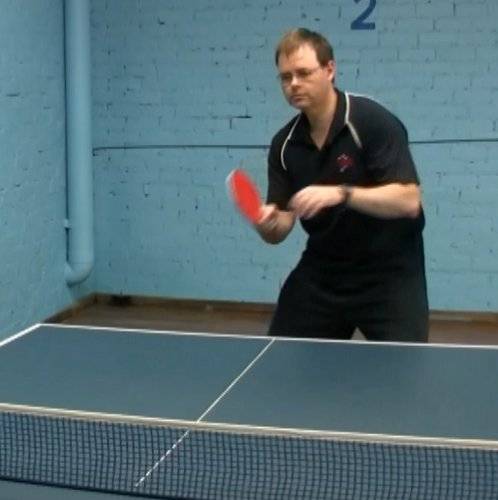
© Greg Letts
Points to look for:
- The player’s right shoulder is dipped a little lower than for a normal ready position, since the player is performing a forehand push drill, and he is “cheating” a little in his recovery.
- The player is also a little closer to the table than would be considered normal during a rally in an actual match.
- The arms are held roughly shoulder width apart, with around a 90 degree angle at the elbow. The bat should be above the table to allow easy stroking of short balls.
Start of Backswing
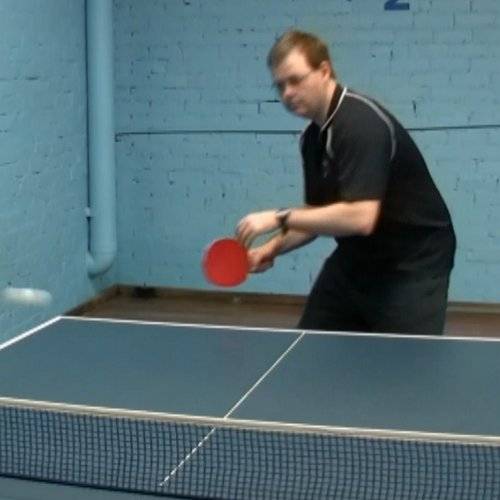
© Greg Letts
The ball is coming to the forehand side with backspin, and the decision has been made to play a forehand push. The backswing begins the stroke.
Points to look for:
- Since the ball is coming a little closer to the player than he would prefer, he has decided to lean a little on his left leg, giving him room to swing without having to using stepping footwork. This is faster than stepping over, but requires a stance that is wide enough to allow the player to lean and still maintain his balance, along with bent knees to allow the player to lean without tipping over.
- While the player is moving his body weight to his left, he is turning his waist and shoulders to the right, in order to move his racket into position. Notice that the racket is being moved by the turning of the shoulders in unison, not by moving the right arm around its shoulder joint.
- The racket is being lowered by a combination of a small amount of leaning forward by the player, a slight dipping of the right shoulder, and a little dropping of the right forearm. Note the the free arm has been turned but not dropped lower.
- Although it can not actually be seen in the photograph, it is possible to determine from the intersection of the right forearm and right upper arm, that the right elbow is a few inches clear of the torso, giving the player adequate room to swing without being cramped.
Middle Of Backswing
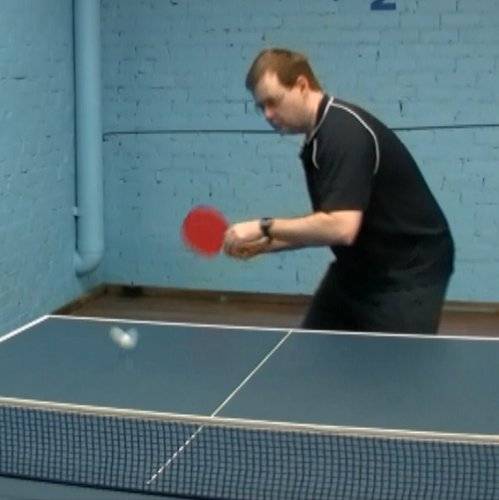
© Greg Letts
The ball is bouncing on the table, and the player has nearly finished moving his racket into position.
Points to look for:
- The racket is being raised slightly, as the player fine tunes its final position. He wants to position his racket directly in line with the direction the ball is traveling, and a few inches above the expected contact point, since his swing will be forwards and a little downwards.
- Note that even though the forehand push is not a powerful stroke, the player has still used quite a lot of body turn in order to bring the racket into position, rather than keeping his waist and torso facing forwards and swinging his playing arm around his right shoulder.
- The “handcuff effect” involving the placement of the racket hand and free hand is evident here.
End Of Backswing
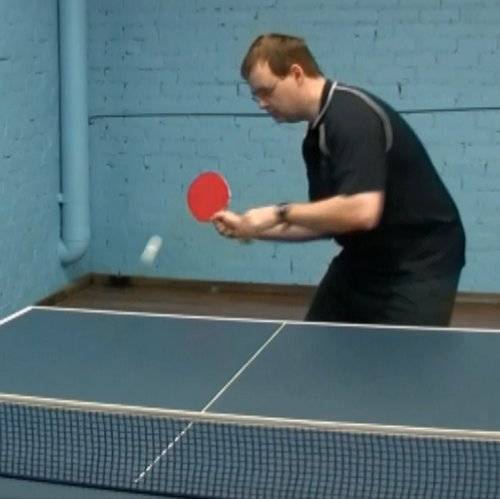
© Greg Letts
The ball is approaching the desired contact point, and the backswing has finished.
Points to look for:
- Note how far to the side of the body the ball is traveling. The player is positioned quite a distance away from the ball.
- The cocking of the racket at the finish of the backswing is evident here. The player intends to snap the wrist forwards and under the ball, in order to add extra backspin to the stroke.
- The player still watching the ball closely.
- Note also that the playing arm has been moved into position without swinging the arm around the right shoulder, in fact the turning of the waist and torso has achieved the positioning of the racket, along with a few inches of movement backwards of the right forearm from the elbow joint.
- The player is almost completely still at this point in the stroke, as shown by the relative lack of blurring of the head and body.
Pre-Contact With The Ball
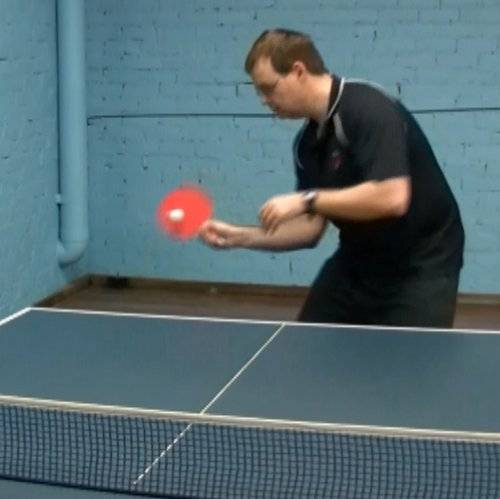
© Greg Letts
The player is about to make contact with the ball.
Points to look for:
- The forward swing has been accomplished by a little turning of the waist and shoulders, and a little swinging of the right forearm around the elbow joint.
- The player is just beginning to snap his wrist forwards and under the ball at this point.
- The player is continuing to concentrate on contacting the ball, and is watching the ball closely.
- Contact will be made in the centre of the racket for maximum control and minimum risk of missing the stroke.
Contact With The Ball
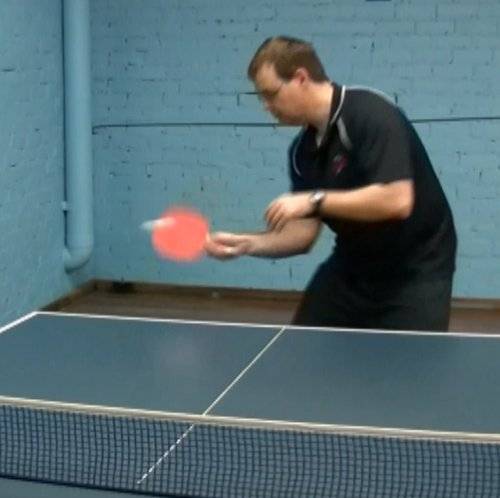
© Greg Letts
Contact has been made with the ball.
Points to look for:
- The player has watched the bat contact the ball.
- Note that even though the racket face is quite obviously open, the ball has not reflected upwards. This is because the player has sliced under the ball with a grippy rubber, which keeps the ball low. If a rubber with little grip had been used with the same swing and bat angle, the ball would be travelling much more upwards.
- The racket has not yet started to move towards the player’s left, but it will do so as the natural forward limit of the swing is reached, and the player continues to turn to his left.
- By comparing this photograph to the previous photograph and the next photograph, it is evident that the player has swung forwards and slightly downwards while hitting the ball.
Start Of Follow Through
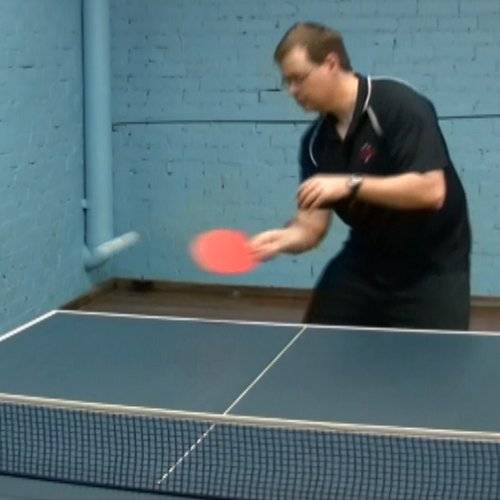
© Greg Letts
The ball is now moving towards the net on a fairly flat trajectory, and the player is starting his follow through.
Points to look for:
- The racket is now starting to move sharply towards the player’s left, as it has reached the end of the forward movement, and the natural swing caused by the player’s body turn and small amount of swing around the right elbow is curving the travel path of the racket.
- The slightly downwards path of the racket is evident from the difference in heights between the free hand and racket hand.
- Note that throughout the stroke, at no time has the right elbow been straightened in order to punch at the ball. The right arm has remained bent at a fixed angle throughout the whole motion.
End Of Follow Through

© Greg Letts
The follow-through has come to an end, and the ball is on its way over the net.
Points to look for:
- There is not a precise endpoint for the follow through, since it blends into the recovery for the next stroke in a smooth manner.
- At this point in the stroke, the player only needs to lift his right shoulder a little, move his racket up a few inches, and push off his left leg back into an evenly distributed body weight stance, and his recovery would be complete.
Return To Ready Position

© Greg Letts
The player returns to his ready position before the next stroke.
Points to look for:
- As mentioned in the previous photograph, the player has lifted his racket a little, reduced the tilting of his shoulders a fraction, and he is now starting to push off his left leg.
- Note that at no time throughout the stroke has the player been off balance or rushed.
- Note also that the right upper arm has actually moved very little from the shoulder joint during the entire stroke. The movement of the racket has been achieved virtually completely from waist and shoulder turn, along with a few inches of swinging around the right elbow, and a little movement of the wrist.

